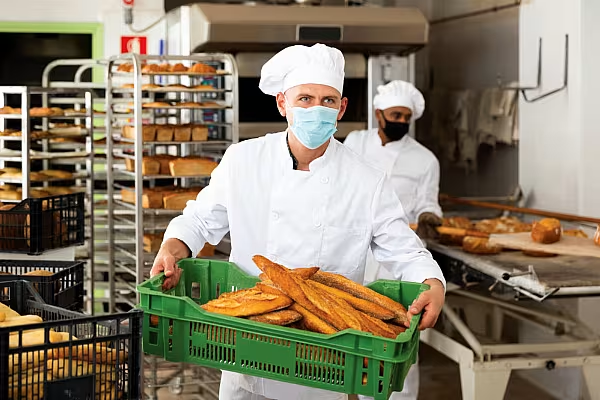The Bakery segment has successfully navigated the pandemic, but challenges remain in terms of repositioning the sector. Stephen Wynne-Jones reports. This article first appeared in ESM July/August 2021.
The Bakery and Pastry Products segment has rolled – no pun intended – with the punches over the past year, as the challenges presented by the COVID-19 pandemic, coupled with changing consumer tastes, led to a reappraisal of how bread-based items are produced, marketed and consumed.
The pandemic led to an immediate shift in what types of products were consumed – the imposition of lockdown measures led to the near-overnight decimation of the impulse and food-to-go segments, while loaves and other packaged bread products were stocked up in bulk. It was a swift, sharp shock to the sector, which required agility and flexible thinking.
More than a year on from the start of the crisis, the pandemic is still with us. While hospitality businesses are starting to reopen across Europe, the sluggishness of the vaccine campaign and the rise of new variants have left businesses, and consumers, on edge.
For those in the bakery sector, while their role as essential workers ensured that they could trade through the crisis, the prolonged closure of the HoReCa channel has had a hugely detrimental effect, prompting many to explore new revenue opportunities or reposition their operations.
Embracing The Online Channel
For example, as Manon Kleijn, spokesperson for Dutch bakery body NBOV, tells ESM, many bakers have looked to the online channel to maintain sales.
“Next to setting up new businesses or outlets, some of our members invested in online outlets and home delivery or expanded their existing online channels,” she says, adding that those that focused on the high-end or specialty market have been able to weather the storm more effectively.
“In general, a focus on high-end products for consumers, which distinguish craft bakeries from mass-produced products, and embracing online business appears to be a sensible choice,” Kleijn adds.
With that in mind ESM presents a snapshot of the bakery industry in selected markets across Europe.
France
Growth in the bakery market in France over the past few years has largely been driven by the catering industry (48% growth between 2010 and 2019) and pastries (44% growth in the same period), while bread products have seen a decline (-24%), according to representative group Fédération des Entrepreneurs de la Boulangerie (FEB).
This past year saw a reversal of that, however, with the sector seeing an overall decrease of 20.8%, compared to 2019, and the catering industry seeing turnover drop by a quarter (24.5%). Decline in the bread category was less pronounced (-15.8%), with shoppers turning to household staples during the crisis.
A study by FEB, published in April and following on from a similar piece of research five years earlier, found that bread holds a prominent place in the French diet, with 87% of consumers reporting that they ‘always have bread at home’ and 48% reporting that they ‘cannot do without it’. As you might expect, the baguette is the bread type most adored by the French, with 41% of consumers citing it as their favourite.
Expectations around the bread category are changing, however, FEB found, with production origin becoming an increasingly important factor. Some 73% of consumers report that it is ‘important’ that the bread they consume is produced from wheat grown in France. Separately, while organic bread products are seen as a positive by consumers, few – just 7% – actually purchase organic bread products.
A positive effect of the pandemic has been an increase in purchasing from local bakers, with shoppers standing ‘in solidarity with small traders’, FEB noted.
Germany
Eager to promote positive health perceptions around bakery, members of Germany’s Verband Deutscher Großbäckereien (Association of Large Bakers) recently pledged its commitment to the government’s action plan for the reduction of sugar, fat and salt in prepared food products.
Commenting on the initiative, which excludes pretzel-makers and other specific pastry segments, association president Ulrike Detmers said that great strides had been made in improving the nutritional component of bakery items in recent years, enabling consumers to “get used to the lower-salt taste without seeing bread consumption decline”.
While the German bakery industry has, like most other markets, taken a hit as a result of the coronavirus pandemic, the country’s bakery products are sought after in other markets, with some 740,000 tonnes of bread and baked goods exported from Germany to other markets in the first half of 2020.
The vast majority – around 661,000 tonnes – was exported to other countries in the European Union, with its products particularly popular in France, Austria, the Netherlands, Great Britain and Italy, according to Verband Deutscher Großbäckereien.
Italy
Local, sustainable and well-priced bakery products are likely to be sought out by consumers after the pandemic subsides, according to a survey carried out by ingredients group Puratos into the product preferences of Italian consumers.
The survey, published in August of last year, found that 74% of consumers favour baked goods made with ingredients of Italian origin, while 57% are seeking out products from companies that adopt a more sustainable standpoint.
Italian consumers are also likely to prefer bakery products that are freshly packed, with one or two days’ shelf life, while affordability is also likely to play a role, with 69% seeking out products that are competitively priced, the study found. It also noted that as many as 82% of Italian consumers practised home-baking during lockdown, meaning that they are very likely to pay close attention to ingredients and perceived health benefits.
The Netherlands
Bread consumption in the Netherlands fell by 5.5% last year, compared to the previous year, with this decline largely driven by the drop-off in HoReCa trade, according to data from Nederlands Bakkerij Centrum (NBC), a data centre for the bakery industry. While supermarkets sold 0.7% more fresh bread and artisanal bakers grew sales by 10% during the pandemic, the 40% drop-off in out-of-home consumption hit the trade hard.
According to an April 2021 survey by Nederlandse Brood- en banketbakkers Ondernemersvereniging (NBOV), whose members mainly comprise craft bakeries, some 40.7% of firms reported 2020 revenues that either equalled or were below their 2019 figures. Though many saw increased traffic through their stores, this was not enough to compensate for so-called ‘third channel’ sales; namely hotels, restaurants, cafés and catering.
“During 2020, a slight recovery was visible: in general, turnovers rose gradually from the onset of the pandemic towards December, mainly resulting from an increase in customers in actual shops,” Manon Kleijn, NBOV spokesperson, tells ESM. “Again, this could not make up for missed turnover from third-channel business.
“On the other hand, we see an increase in new businesses in the business-to-consumer market, especially the ones selling high-end products, such as sourdough bakeries and specialised chocolate shops. These are either existing businesses that started new consumer outlets or entirely new businesses.”
In short, as Kleijn explains, there are positive signs that the bakery sector will be able to navigate through this particular crisis. “Some 89% of our members reported that they think they will survive this crisis,” she says. “For some, government funding for keeping businesses going has been essential, others were able to fend for themselves.
“Whether businesses will be able to recover to 2019 levels depends heavily on their ability to adapt their businesses if necessary, and on measures to contain the virus.”
Spain
According to ASEMAC, the Spanish Bakery, Pastry and Confectionery Industry Association, the Spanish bakery sector saw a 17.6% decrease in turnover last year, while production was also down (-12.4%) as a result of lower demand within HoReCa.
Describing the past year as an “unprecedented situation” for the country’s bakers, the president of ASEMAC, Felipe Ruano, cited lockdown measures, a drop in tourism “to 1960s’ levels”, and a change in consumption habits, with more consumers opting for packaged bread, rather than loose products.
However, as the year progresses, Ruano believes that the industry will get back onto something of an even footing.
Provided that the epidemiological situation improves and the vaccine roll-out proves successful, “I think we could recover a large part of what was lost in 2020 and make a good start again in 2022,” he said, “although it will likely not be until 2023 when we see figures similar to those reported in 2019.”
This past March saw the hosting of COPAN21, a forum for debate and exchange of ideas around the Spanish bakery and pastry sector. One of the key talking points of the event was around enabling the industry to build back better, tapping into changed consumer expectations.
“We are the best-informed citizens in history,” commented the Ministerio de Agricultura, Pesca y Alimentación’s José Miguel Herrero. “Consumers read labels, seek information on how to eat better, and are aware that diet influences their health and that they should lead a healthier lifestyle,” or, to put it another way, as ASEMAC’s Felipe Ruano explained, “The future of bread will be good for those who make good bread.”
UK
According to the chairman of the UK’s Federation of Bakers (FOB), Mike Roberts, the past year has been an “unprecedented” one for the British bakery sector, with a global health crisis, Brexit, regulatory issues, and the declining consumption of bread products creating something of a perfect storm for the industry.
In response, the industry has sought to forge new collaborations with government and regulatory bodies, such as Public Health England, DHSC, Defra, WRAP and the Health and Safety Executive, while it has also launched a proactive PR campaign in collaboration with the British Dietetic Association (BDA), which aims to educate consumers and the media on ‘all that bread delivers from a nutritional perspective’ and promote measures to reduce salt and other health-oriented goals.
A positive for the industry is that there are already signs of a bounce-back, particularly when it comes to the food-to-go segment. The Lumina Intelligence UK Food To Go Market Report 2021, forecasts 31.6% growth for this channel this year. Within this, convenience store grab-and-go and the sandwich/bakery market is expected to recover swiftly, to around 74% of its pre-pandemic value this year.
© 2021 European Supermarket Magazine. Article by Stephen Wynne-Jones. For more Fresh Produce news, click here. Click subscribe to sign up to ESM: European Supermarket Magazine.














